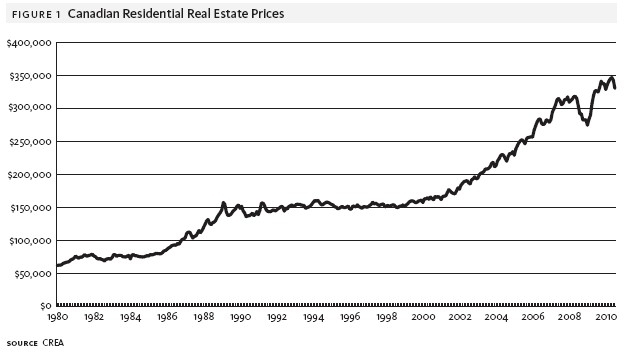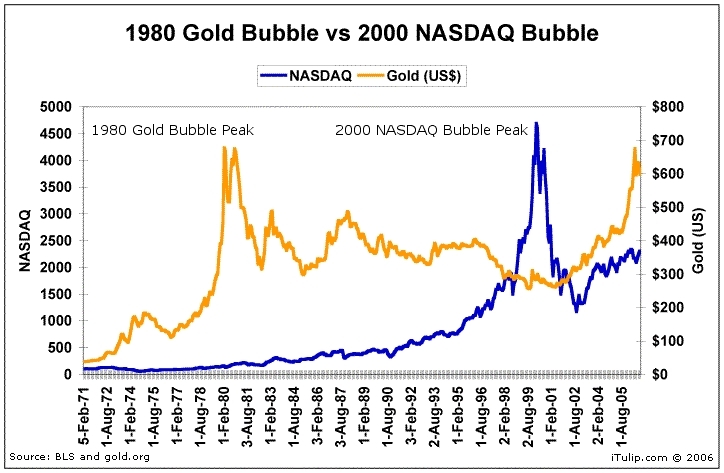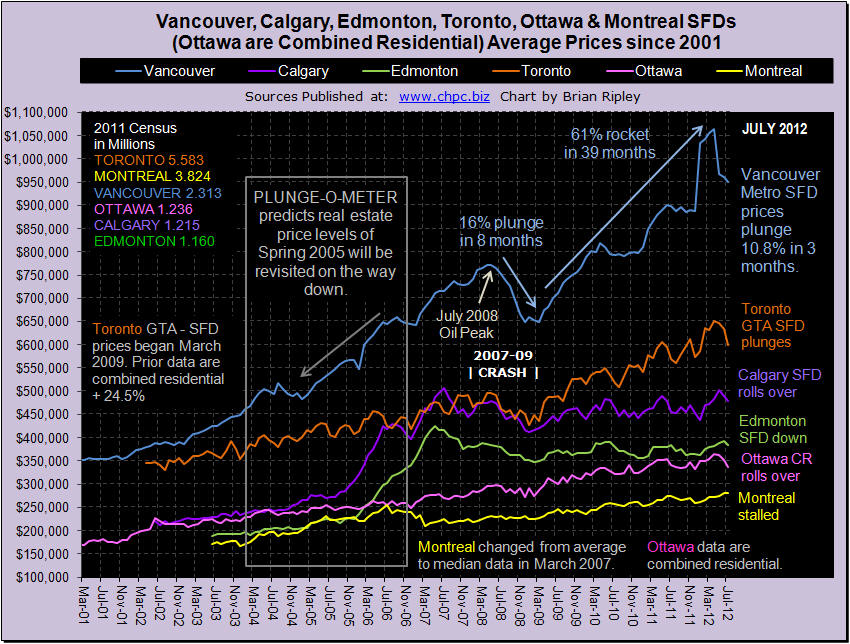Personal Finance
Bubble, Bubble, Toil and Trouble?
A correction in the Canadian housing market is looking ever more likely. In 2001, both Canada and the US lowered interest rates ( cheap money) which helped fuel a housing boom. In 2008 the US experienced a marked reversal in housing prices, bringing them in line to their long term growth rates. In Canada this did not happen.

We don’t feel that Canada magically avoided this correction – it just hasn’t happened yet. There are several factors that could contribute to a significant correction in Canada’s housing market.
- Our personal savings rate is decreasing (currently only 2.9%)
- Our consumer debt level is increasing (currently $25,597/person)
- Growth in housing prices continues to vastly outpace growth in rents
- Interest rates are at record lows and are poised to rise
- New mortgage rules have been instituted to slow growth
Historically, housings prices have been a function of the rents they can achieve. If it gets too expensive to buy, people will rent. This will drive housing prices down and bid up prices for rents, creating an equilibrium. In 2001, this relationship started to break down and housing prices rose significantly more than rents. Was this simply a matter of people willing to pay a premium for home ownership? Possibly, but a more likely explanation is that there was a bubble fueled by cheap credit. People justified making offers over asking prices because there was an expectation that housing prices would be higher the next year. More money was available to bid up prices and bidding wars ensued.
In the US housing prices have since moved to a level where we would expect them based on the long term house price to rent ratio. In Canada, this ratio has not experienced a correction and housing prices continue to be significantly higher than rents. This difference is muted with lower interest rates (which lowers carrying costs), but as interest rates rise, it will become more apparent as mortgages come up for renewal.
If you any questions about this report, or to discuss how Euro Pacific can help manage your portfolio, please contact me.
Kind regards,
Dan Simon
Investment Consultant
w. 416.479.8996 | f. 647.776.3284
c. 416.602.7960
tf. 888.216.9779 x403
dan.simon@europac.ca“>dan.simon@europac.ca
Euro Pacific Canada Inc.
130 King Street West | Exchange Tower
Suite 2820 | Box 20
Toronto, ON, M5X 1A9
www.europac.ca

EB: With more monetary easing by central banks around the world – where do you think valuation will be skewed? Which stock markets are going to be most prone to ‘bubble-like’ characteristics?
MARC FABER : Given that given that zero interest rates are in the US in nominal terms and if I take say a more realistic view of cost of living increases. Last week, NY taxi prices went up 19%. If I consider that, I think that US stocks may for the time-being actually rally but I have doubts that they will rally above the highs at 1422 we saw in April of this year on the S&P.
I think that it’s possible that the US may rally as the whole world thinks that the US has natural gas and there will be a re-industrialisation in America. The mood amongst international investors is that the US is the least bad choice.
I’ve always said if you give me the choice to buy a 10 year treasury at the yield of 1.5% or Johnson&Johnson, I’d rather buy Johnson&Johnson with a ten-year view. But as I said, if I look at all the options that I now have, I can see that European stocks are now terribly depressed.
I still own Asian shares and again the reason I own them is we have next to zero deposit rates and my portfolio of Asian shares has an average yield of say 5-6%. If I look at my investments, I think that they might go down 30% but I don’t think there will be massive dividend cuts – some here and there but not across the entire portfolio.
I still keep a lot of cash because if the markets drop another 30% – which I hope they will do – I will then invest in equities. – in citywire



Michael Snyder: How in the world is someone supposed to actually prepare for an economic collapse? What should you do with your money? How can you make sure that your family is going to be okay? How can you prepare if your resources are extremely limited? These are the kinds of questions people ask me all the time.
Once people understand that the economy has been collapsing and will continue to collapse, then the next step for most of them is that they want to get prepared for the storm that is coming. So where should someone get started? Well, the truth is that no two people are facing the exact same set of circumstances, so preparation is going to look different for each individual. But there are certain core principles that we can all benefit from. For example, when a financial storm is coming that is not the time to be blowing thousands of dollars on vacations and new toys. You would be surprised at how many people there are that claim that they have no extra money in their budgets and yet somehow have plenty of money to run down to Wal-Mart and buy a big stack of DVDs. When times are difficult, each hard-earned dollar becomes much more precious, and we all need to start getting into the habit of making the most out of our limited resources. The seemingly endless prosperity that we have all been enjoying for decades is coming to an end, and most of us have absolutely no experience on how to deal with truly hard times. If you are under the age of 60, it might be a really good idea to read a book or two on what conditions were like during the Great Depression of the 1930s. There is a lot that we can learn from our own history.
…. for the 14 Questions & Answers read more HERE


The chart above shows the average detached housing prices for Vancouver, Calgary, Edmonton, Toronto, Ottawa* and Montréal* (*Ottawa are combined residential; Montreal are median not average). In July 2012 urban flippers headed to the exits and buyers retreated to the sidelines as huge sales resistance across Canada (Scorecard) continued to grow with double digit drops like Toronto SFD sales down 23.6% M/M and Vancouver SFD sales down 28.5% Y/Y. Pricing power has been hit in the hot markets of Vancouver and Toronto (Plunge-O-Meter) with SFDs losing 10.8% equity in Vancouver and 7.7% SFD equity loss in Toronto in just the last 3 months. Despite low rates and negative yields, the risk of equity loss is changing buyer sentiment. In my neighborhood walk about through open houses, the pitch is the same… “Price Reduced”.

Last week: my blog comments noted that, “This market wants to go higher“…this week: the major US and European stock indices all closed at new 3 month highs despite the mid-week sell-off on the lack of new programs from the Fed and the ECB. The US$ Index closed at a one month low…the AUD went to a 4 month high, while the CAD touched par for the first time in 3 months…US and CAD government bond yields rose.
Last week I noted:
1) We had Key Weekly Reversals higher in Euro, Swiss, CAD, AUD, DJI, S+P, TSE, Gold (in USD terms) US treasury yields from 2 through 30 year maturities, and a Key Weekly Reversal lower in the US Dollar Index.
2) Despite the manic-depressive mood swings, despite the torrent of capital rushing into perceived safe haven bonds, despite the seemingly intractable European debt crisis, despite the sluggish US and global economy… it seems that THE STOCK MARKET WANTS TO GO HIGHER…the DJI has rallied over 1000 points from the June 4 lows…over 2,700 points from the October 4 lows.
3) Why? It seems as though we are mainly trading off macro political or central bank inspired headlines…or rumors…its seems as though the markets expect central banks will take further reflationary action…will print more money…which will inspire risk on…and higher asset prices.
4) The technical view: Technicians make the point that you can never know all you need to know to make the best market decisions…but if you look at the market you can see what it’s doing…so freeyourself of your opinions about what the market should be doing…and look at what it is doing…the US stock market rallied right through this month’s previous highs and closed at its best levels in nearly three months…this market is a classic case of climbing a wall of worry.
5) There has been a huge amount of cash sitting on the sidelines for the past few years due to economic and political uncertainty and that money could come into this market…taking it much higher…yes, the economic and political uncertainty that has kept that cash on the sidelines still exists…yes, those problems may only be intensifying…and yes, it’s entirely possible that the stock market may reverse tomorrow and drop a few thousand points before Christmas…but…since March, 2009, the US stock market has been trending higher and, as skeptical as I am and as skeptical as I have been, I have to say it looks like this market wants to go higher.
Trading:
For my short term trading accounts I’m long the
Market Psychology:
The dramatic crashes in the stock market, the commodity market, and the housing market over the last five years caused a real crash in investor confidence…in investor’s willingness to take on risk…we see that demonstrated by the high levels of corporate cash as companies are collectively cautious….with good reason, perhaps, but cautious none-the-less. Certainly investors are more likely to see the glass half-empty now than they were during the times of irrational exuberance. So despite the stock market rallies we can see in the charts below the tone remains fretful…fearful…as though worried that all the gains could be gone in a heartbeat…a classic example of a market climbing a wall of worry.
Charts Section:
The US stock market turned higher on (Key Turn Date) June 4 and has chopped higher ever since…now at its best levels in 3 months

The US stock market has been grinding higher for over 3 years…note the very rare and very powerful Monthly Key Reversal Higher in October 2011 (the DJI is up 2700 points from the Oct 4 Key Turn Date.)

The AUD (the high-beta risk-on/risk-off currency) has rallied over 10% since the June 4 Key Turn Date…

Gold made its All Time High above $1900 last August and has found a floor around $1525-30 several times since then. It popped above its s/t downtrend the past two weeks on USD weakness…a rally above $1630 could set up a test of $1700+ while a breakdown below $1550 would set up a test, and likely a break, of the $1525-30 floor.


Victor Adair
Senior Vice President and Derivatives Portfolio Manager
Contact Victor E-mail @ vadair@union-securities.com” data-mce-href=”mailto:vadair@union-securities.com“>vadair@union-securities.com
Victor Adair is a Senior Vice President and Derivatives Portfolio Manager at Union Securities Ltd. Victor began trading financial markets over 40 years ago and has held a number of senior positions during his long career as a commodity and stockbroker. He provides daily market commentary on CKNW AM 980 radio Vancouver and is nationally syndicated on Mike Campbell’s weekly Moneytalks radio show.
Victor’s trading focus is primarily on the currency, precious metal, interest rate and stock index markets and his clients are high net worth individuals and corporations.












